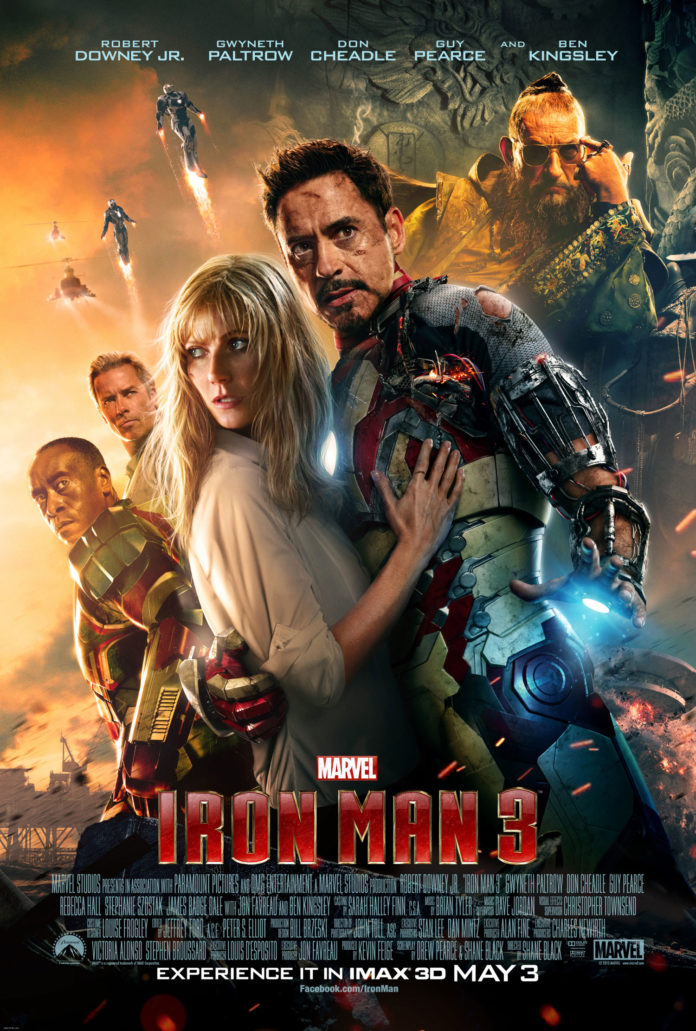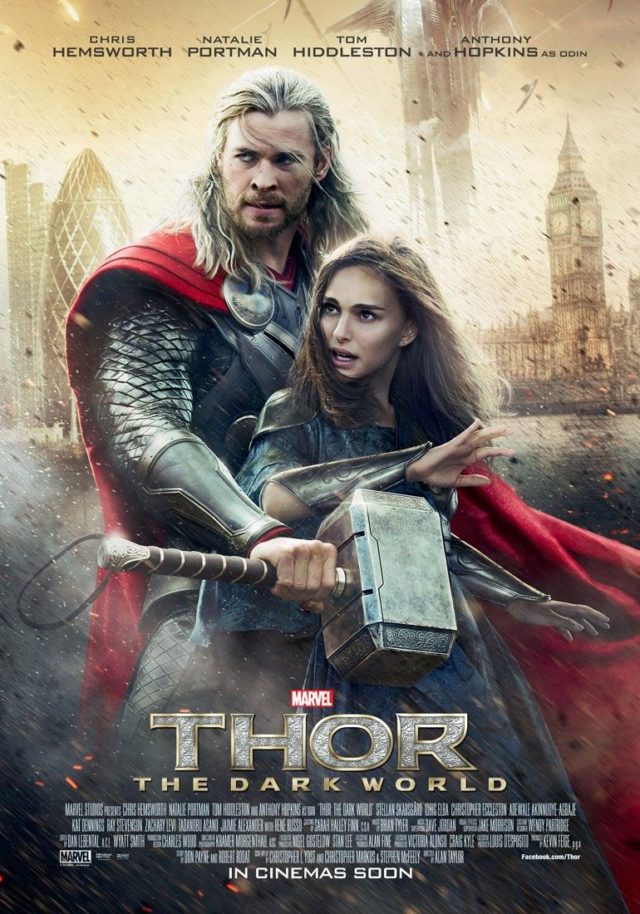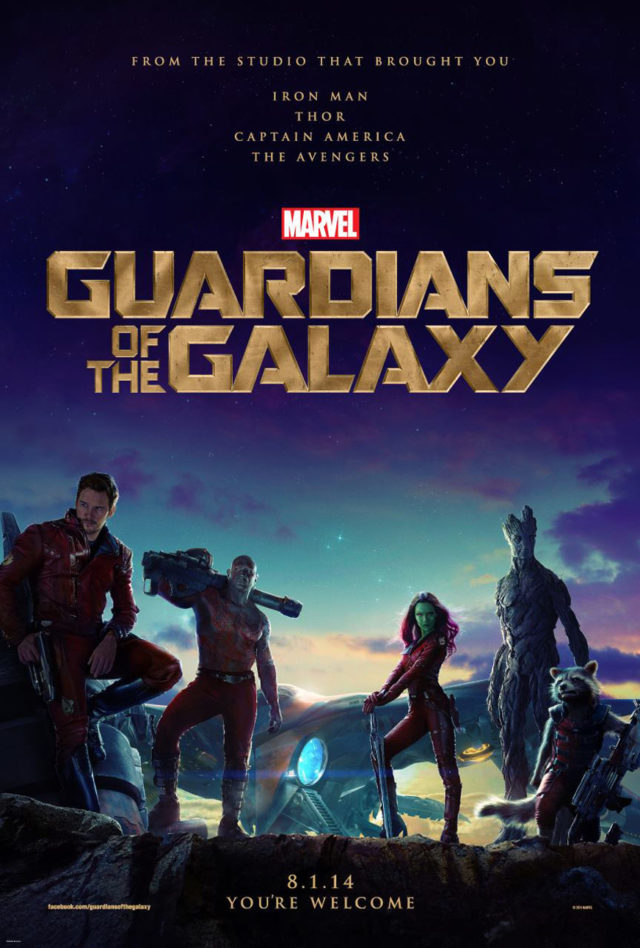By Molly Atchison | Print Managing Editor
Following the recent release of Marvel’s “Black Panther” and in anticipation of the upcoming “Avengers: Infinity War” release, it is the perfect time to revisit the Marvel Cinematic Universe (MCU). Over the next 6 weeks, leading up to the May release of the long-awaited “Infinity War,” I will be breaking down a group of movies in the MCU based off Digg.com’s Best Way to Watch the Marvel Cinematic Universe list. So sit down, grab your popcorn and your reading glasses, and prepare to have your Marvel-loving minds blown.
Unfortunately (or not, if you’re tired of excessively long articles), this week’s movie sequence is sorely lacking in entertainment value. “Iron Man 3”, “Thor: The Dark World” and “Guardians of the Galaxy” are up next, and as the MCU journeys through time and space, our heroes will face trials and tribulations unlike any other.
Iron Man 3 (2013):
In this movie, we see the end of the first Avenger as we know him. Immediately following the intergalactic attacks as seen in “The Avengers,” Tony Stark’s life falls into chaos. He not only faces a formidable opponent, but also finds himself in personal crisis. Even though (almost) everyone knows that Iron Man is still present throughout the remainder of the series, this movie made plenty of people question the longevity of one of the most popular MCU characters.
Series Relevance: The question plaguing viewers’ minds about Iron Man revolves around his famous glowing chest piece. Will the shrapnel in Stark’s heart eventually kill him? This is just one of the questions being answered between the first movie and the second. In this movie, we see tangible effects of the alien attack on earth from the first Iron Man, which isn’t always present in superhero movies. New York City is undergoing a substantial amount of rebuilding. Viewers witness Stark experience symptoms of PTSD, which results a major personal crisis. Ultimately, Stark displays serious character development, fully transforming from the suave, carefree bachelor we know and love into a hardened hero with an incredibly cynical outlook. Does the transition from brash confidence to fear and cautious negativity make us love Stark any less? Absolutely not. Does it allude to a coming rift in the Avengers team? Absolutely. This movie wraps up loose ends in order to bring new characters (such as the beloved Happy Hogan) into the mix and to solidify Stark’s new role as the voice of disillusionment in the team.
Entertainment Value: This movie was enjoyable but much less enthusiastically received than the first “Iron Man.” Perhaps this is due to viewer’s desire to see Iron Man continue on as the debonaire hero with flashy tricks and a good girlfriend, or perhaps it’s due to the convoluted plot line involving medical experiments, presidential assassination plots and stolen identity issues. Either way, while this movie was technically appealing and important to the growth of a recurring character, it was a less-than thrilling ending to a hero arc, especially since so many were expecting a happy conclusion. Personally, I enjoy any ending that throws caution to the wind and avoids rainbows and butterflies, and with the destruction of the supersuits, the loss of Tony Stark’s “heart” and the crisp, clean transition of optimism to cautious pessimism, “Iron Man 3” lived up to the hype it was advertised to have. I still wish there had been less focus on the completely outlandish presidential assassination plot, and the annoyingly unconvincing villain Aldrich Killian, portrayed by Guy Pearce. In the end, though, Pepper Potts saved the day, and viewers are left with a new and improved Iron Man, complete with new issues and a new heart to boot.
Cultural/Political Value: “Iron Man 3” redeems the medical experimentation concept that The Incredible Hulk butchered so badly. It introduces a classic, idealist doctor who attempts to help the world and consequently creates a deadly medical anomaly. Additionally, viewers witness the completion of a circle that began in the very first Iron Man movie: the visualization of the effects of war on humans. The movie appropriately tied Stark’s war-related injury to the medical experiment, which centered around curing veterans of dangerous shrapnel and explosive injuries. Stark witnesses the effects of the experiment in a positive light because it cures long-lasting injuries and could possibly cure his own; however, the supposed cure does more harm than good. This may be an allusion to the supposed aid given to veterans in the real world, or it may simply be a plot device. Whatever the case, it was a poignant way to bring Iron Man back to its roots, and to bring awareness to the plight of veterans and those who suffer from war-related injuries.
Thor: The Dark World (2013):
In an odd, Lord of the Rings-style departure from the traditional superhero plot, “Thor: The Dark World” is a descent into the ever-convoluted world of inter-realm travel. Unfortunately, Thor and his team of ragtag human sidekicks failed to entertain this time, and the movie not only became stale halfway through, but also failed to show any sort of interesting character growth. It did, however, further an increasingly complicated relationship between Thor and his brother, part-time villain Loki.
Series Relevance: “Thor: The Dark World” exists for the sole purpose of furthering the Infinity stone plot line. Aether, the dark matter contained in one of the seven magical rocks, is released and channeled by the dark elven king Malekith, who desires to plunge each realm into darkness for personal gain. In this, the movie is centered on a ridiculously outdated damsel-in-distress concept, where Thor’s love interest is literally used as bait in order to lure the evil bad guy into a trap. This film fall into all of the ridiculous tropes that others have tried to avoid and lacks a purpose in the MCU, aside from reiterating the concept of interdimensional travel that was already clearly represented in the first “Thor” and “The Avengers.” Perhaps the only redeeming factor is that it endears the audience more to Thor’s counterpart, Loki, who became a fan favorite with his slightly comical, completely sympathetic plot in the first “Thor” and “The Avengers.” While the Thor arc is most closely related to the MCU arc in general – with most of the all-hero screen-time being spent fighting villains from his dimensions – “Thor: The Dark World” fell surprisingly flat for a multi-dimensional plot line.
Entertainment Value: Unfortunately, there wasn’t much entertainment value in this film. As far as sequels go, this tends to be the case, but Thor desperately needed some revitalization after the slightly-more-than-mediocre reception of the first Thor movie. Thor definitely needed to come off as more than a pretty face, and although he does take on more of a leadership role in his own kingdom, he is still often perceived as a sidekick among sidekicks. The most exciting part of the movie, unfortunately, was the death of Thor’s mother, as it gave a brief moment of emotion to an otherwise dull movie. Still, nobody likes to be entertained by death, and a superhero movie definitely requires more than a revenge mission to keep it on its feet. Technically, the movie was stellar, but that’s what we see as we move forward with almost all of the upcoming movies. Therefore it’s nothing special and not even remotely redeeming.
Cultural/Political Value: Once again, Thor lacks a political or cultural relevance, other than to revert gender roles back about 25 years, which nobody wants. The played-out woman-ruins-everything-so-that-man-can-fix-it concept was one that I, and many other women, had hoped would be put to rest in the MCU. Unfortunately, the male-dominated superhero world was only furthered by the negative portrayal of Dr. Jane Foster in this movie. Perhaps that is why her character was written out of the third Thor movie, but it was too little too late. Audiences had to sit through this ridiculous oversight for two and a half hours.
Guardians of the Galaxy (2014):
One of the most widely controversial moves in the MCU, the addition of “Guardians of the Galaxy” into the mix shed a new light on the concept of interdimensional travel and brought a refreshing comedic air to an otherwise dark and increasingly depressing phase of the MCU. The introduction of the Guardians — which includes Peter Quill or Starlord, played by Chris Pratt, Gamora, played by Zoe Saldana, the animated raccoon Rocket, voiced by Bradley Cooper, the tree figure Groot, voiced (if you can call it that) by Vin Diesel and Drax, played by Jon Bautista — offers another outlet for those who were previously dubious about the intergalactic concept the MCU was trying to perpetuate.
Series Relevance: For those struggling to grasp the concept of multiple realms, worlds and interdimensional travel, this movie might make it more tangible for you. The concept of space travel is a well-known and understood idea, and one that members of the human race can latch onto much easier than plots revolving around magic portals and superhuman intervention. Similarly, this movie brings in a side-crew that will later pop up to help the Avengers on their missions. It presents the Guardians as their own individual entity, and one that can easily be continued in a series. It once again introduces the Collector as a possible villain, and more importantly, it presents us with the major villain in “Infinity War”: Thanos, the destroyer. Although Thanos is less present in this movie, his starring role is yet to come, and Guardians offers us a glimpse into the potential for this bad guy. It also brings yet another infinity stone into the mix and better explains what the devastating effects of the infinity stones are. However, Guardians brings to the table a potential way for the infinity stone power to be channeled by the good guys, which could completely change the narrative for the Avengers.
Entertainment Value: With such a dark, depressing start to phase two, complete with evil elves and the destruction of Iron Man suits, it was about time we got some comedy in the MCU. Peter Quill brings witty quips and adorable innocence to the universe in addition to an amazing soundtrack. The 80s jam he blares in his spaceship, The Milano, made me want to get up and dance in the theater. The obstinance of Rocket, the cluelessness of Drax and, most importantly, the monosyllabic yet incredibly evocative vocabulary of Groot brought audiences to tears with laughter. Although the characters were significantly less relatable than the likes of Captain America and Iron Man, the film was littered with open-ended opportunities for further Avengers connections, and the colorful filming was a drastic departure from the gritty color schemes of the previous two movies. Although it seemed to stand on its own better than it lumped in with the rest of the MCU, “Guardians of the Galaxy” provided marvel fans with some laughs that they much deserved.
Cultural/Political Value: “Guardians of the Galaxy” touches on plenty of smaller themes, from animal cruelty to abusive and manipulative parent-child relationships, but struggled to bring a formal political voice to the table. However, an important part of this movie is the concept of bringing people from different backgrounds and views together to work toward a common goal. The characters are literally from different worlds and have each experienced horror of some kind. They eventually fall together as a group through their reluctant realization that they are the only thing standing between their world and mass destruction.
Phase two is already riddled with a variety of different plots, merging beloved heroes with new faces, and it is clear that it’s only going to get more interesting as we go along. Tune in next week to find out more about the Guardians and Captain America, and to read about the next phase transition as we move towards the Infinity War release date on April 25.









